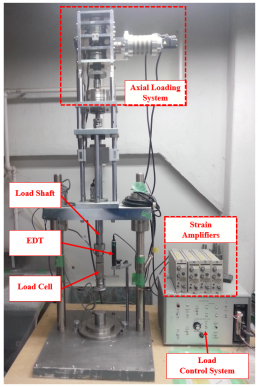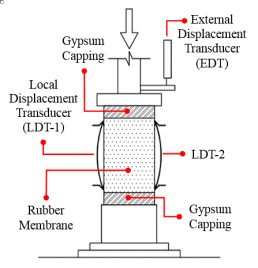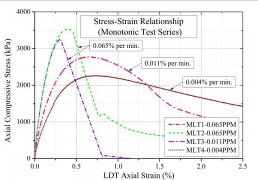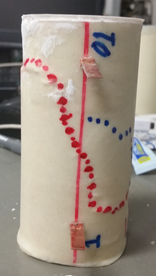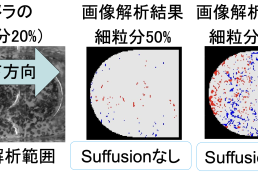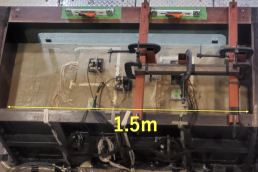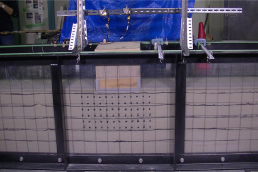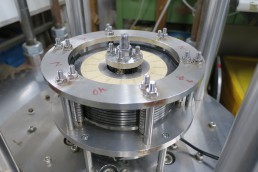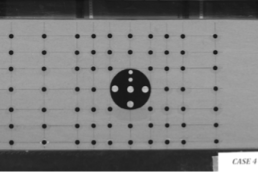Research Objectives / 研究目的
It is a well-acknowledged fact that mechanical behavior and deformation characteristics of soft rocks and other cemented geomaterials are principally governed by the loading/strain rate. Therefore, the consistency and preciseness of constitutive modeling of geomaterials indispensably require the rational evaluation of these loading rate dependent characteristics. (Tatsuoka et al., 2008; Miyashita et al., 2015)
軟岩および種々のコンクリート改良土の強度変形特性が載荷・ひずみ速度に支配されることはよく知られている.構成モデルの構築ならびに高度化に際しては,これらの載荷速度依存性を合理的に評価することが必要となる.
Material and Testing Conditions / 材料および試験条件
In order to examine these loading rate effects, laboratory prepared Gypsum Mixed Sand (GMS) specimens are being tested under unconfined monotonic loading conditions at different axial loading rates. In addition, the effects of loading rate under cyclic and creep loading conditions are also included in the scope of the current study. In addition to external axial strain measurements using conventional external displacement transducer (EDT); a pair of simple and relatively precise device named “Local Displacement Transducer (LDT)”, capable of measuring small local axial strains ranging from 10-6 to 10-2, is being utilized to measure local axial strains. (Maqsood et al., 2016, 2017)
載荷速度の影響を調べるため,石膏混入砂を用いた一軸圧縮試験を種々の載荷速度で行う.また,繰り返し載荷特性およびクリープ特性についての検討も実施している.実験では,外部変位計による巨視的な変形の計測に加えて,LDT(Local Displacement Transducer)を用いて局所的な変形を高精度(ひずみレベル:10-6 – 10-2)に計測する(図1,図2).(Maqsood et al., 2016, 2017)
Fig.1 Unconfined Compression Machine
Fig.2 Schematic sketch of External (EDT) and Local (LDT) Displacement Transducers (Maqsood et al., 2016)
Current Findings / これまでの結果
The current results suggests that Isotach behavior is clearly witnessed for GMS and stress-strain responses in the pre-peak regions are primarily governed by the applied loading rate, as shown in Fig. 3. In all of the creep tests, strain rate generally decreases under the action of sustained loading and reaches a minimum/threshold value. Afterwards, strain rate increases from this threshold and at a certain value of strain rate creep failure occur. Moreover, the inclinations of shear bands formed in specimens subjected to higher rates of loading are quite steeper than that of the specimens tested at relatively slower loading rates, as shown in Fig. 4. (Maqsood et al., 2016, 2017)
これまでの実験結果から,ピーク強度前の応力ひずみ関係には明らかなisotach挙動が確認された(図3).一方,クリープ試験では,応力一定下でひずみ速度は徐々に小さくなり最小値/閾値になが,その後時間が進行すると再びひずみ速度は大きくなり,最終的には(クリープ)破壊を迎えることが分かった.さらには,せん断帯の角度は,ひずみ速度が大きいほど急になった(図4).
Fig. 3 Stress-strain relationship of GMS specimens subjected to unconfined monotonic loading (Maqsood et. al, 2017)
(a)0.065% per min.
(b) 0.004% per min.
Fig. 4 Effects of loading rate on failure pattern of GMS specimens (Maqsood et al., 2017)
More Details...
1)Maqsood, Z., and Koseki, J. (2017) Effects of loading rate on the behaviour of Gypsum Mixed Sand, The 19th International Summer Symposium, JSCE, Fukuoka, Japan
2)Maqsood, Z., & Koseki, J. (2017) Loading rate dependent characteristics of geomaterials, 14th International Conference on New Challenges in Geotechnical Engineering, ICNCGE-2017, Lahore, Pakistan, pp 131-134.
3)Maqsood, Z. and Koseki, J. (2016). Use of local strain measurements for rational evaluation of loading rate dependency of Gypsum Mixed Sand. The 18th International Summer Symposium, JSCE, p.69-70.
4)Maqsood, Z., & Koseki, J. (2015). Behavior of Gypsum Mixed Sand under Unconfined Monotonic and Cyclic Loading Conditions. GeoKanto, Kanto Branch of Japanese Geotechnical Society, Tokyo.
5)Miyashita, Y., Koseki, J., Namikawa, K., and Matsumoto, M. (2015). Study on viscous property of sedimentary soft rock in drained triaxial and unconfined compression tests. Deformation Characteristics of Geomaterials, IOS Press, Vol.6, pp. 575-58.
6)Tatsuoka, F., Di Benedetto, H., Enomoto, T., Kawabe, S. and Kongkitkul, W. (2008). Various viscosity types of geomaterials in shear and their mathematical expression. Soils and Foundations, Japanese Geotechnical Society, 48(1), pp. 41-60.
